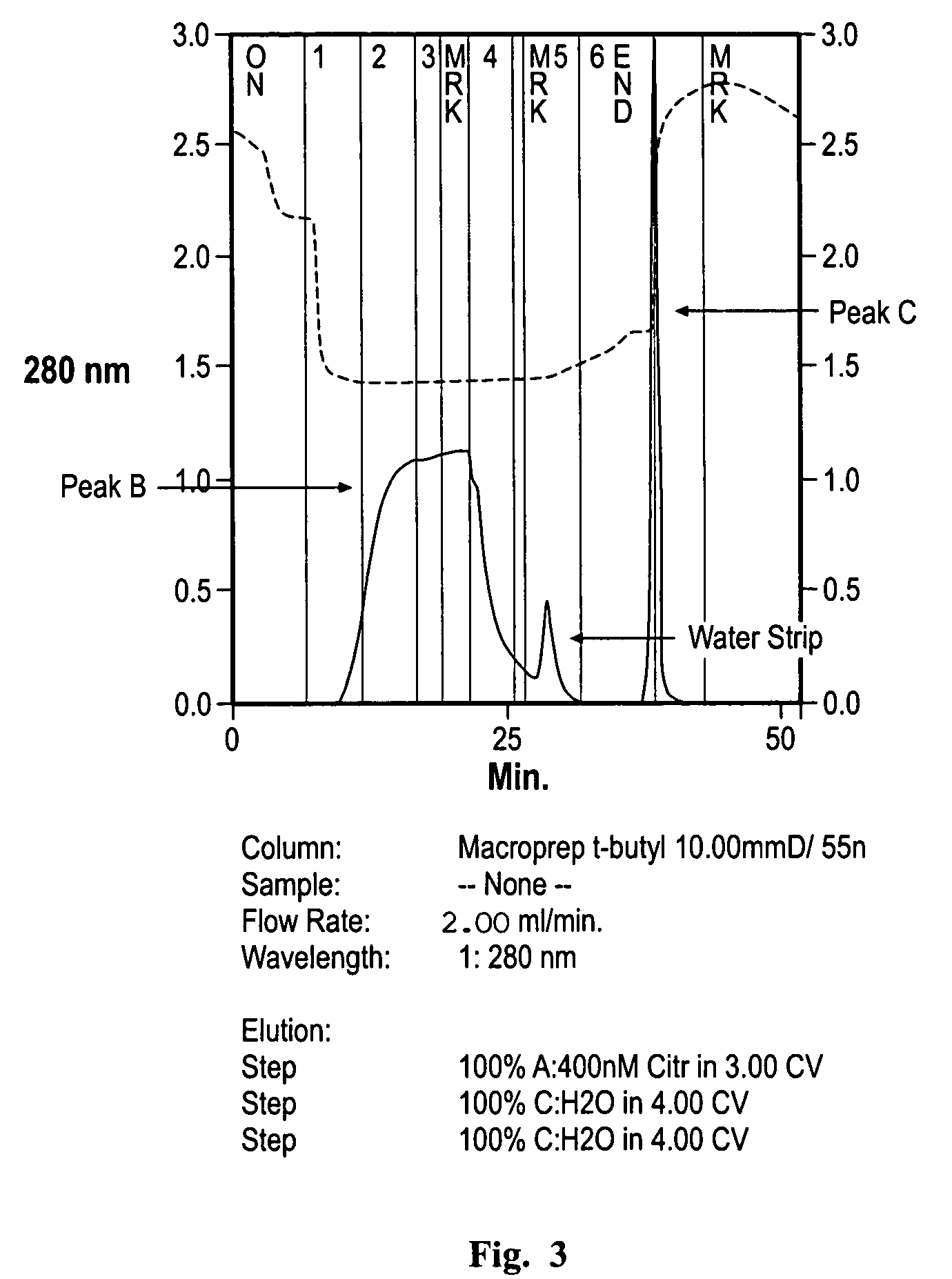Process for purifying proteins in a hydrophobic interaction chromatography flow-through fraction
a technology of hydrophobic interaction and chromatography, which is applied in the field of protein purification using hydrophobic interaction chromatography, can solve the problems of limited usefulness of hic in the flow-through mode, difficult removal of such a broad spectrum of impurities, and few chromatographic steps are capable of removing all these impurities from a product, etc., to achieve high selective binding, improve efficiency and cost of protein purification process, and improve the effect of protein recovery
- Summary
- Abstract
- Description
- Claims
- Application Information
AI Technical Summary
Benefits of technology
Problems solved by technology
Method used
Image
Examples
example 1
Purification of IL1R-II
[0066]An HIC flow-through step on Macroprep t-butyl (BioRad Laboratories, Inc.) was employed in purifying a soluble extracellular domain of IL1R-II. A sample containing IL-1R-II was first subjected to purification on a TMAE Fractogel anion-exchange column using 25 mM Tris, pH 8 as the equilibration and wash buffer and 25 mM Tris, 150 mM NaCl, pH 8 as the elution buffer. The HIC step was performed at pH 7.0 with 600 mM citrate in the load buffer. FIG. 1 shows a representative chromatogram of the flow-through step on the t-butyl resin. As can be seen in the figure, a majority (˜90% by a quantitative assay) of the loaded protein flows through under these conditions. An elution peak is observed during a wash with 25 mM phosphate, pH 7.0 and a smaller peak was observed in the 0.5N NaOH strip.
[0067]Table 1 shows the CHO host cell protein (CHOP) levels in the HIC load, HIC flow-through, and HIC elution fractions from the flow-through purification of IL1R-II shown in ...
example 2
Purification of RANK:Fc
[0070]The HIC step was employed after the Protein A purification step during downstream processing of RANK:Fc, an Fc fusion protein. At this stage in the process, the predominant impurities in the product include CHOP (˜5-10000 ppm), leached protein A (50-200 ppm), high molecular weight aggregate (2-5%) and the peak C form of the protein (5-10%). The peak C form of the protein is potentially misfolded RANK:Fc that has been found to have a lower binding activity than the peak B (main peak) form.
[0071]RANK:Fc was purified in an HIC flow-through step using a Macroprep t-butyl resin prepared in accordance with the manufacture's directions. The column was prepared to a capacity of 15 mg / ml at an operating flow rate of 2 cm / min and sanitized with 0.5 NaOH. Following viral inactivation of the Protein A eluate pool, the eluate was diluted with 0.6M citrate solution (pH 6.0, 1:1.75 protein:salt ratio) to raise the final salt concentration of the feed load to 0.4M citra...
example 3
Selectivity of Branched Hydrocarbon Functional Groups for Alternate Forms of RANK:Fc
[0074]A range of HIC support media were compared independently for their selectivity between the peak B and C forms of RANK:Fc as defined by an HIC assay consisting of linear gradient elution (1 to 0M ammonium sulfate) on a TSK Butyl NPR column. Specifically, the chromatography media that were tested included (a) Macroprep t-butyl, (b) TosoHaas Butyl 650M, (c) Butyl Sepharose FF, (d) TosoHaas Phenyl 650M, and (e) TosoHaas Ether 650M. Analytical injections (0.5 mL at a concentration range of 0.5-2 mg / mL of peaks B and C (obtained from a preparative linear gradient experiment on the TSK Butyl NPR analytical column) were loaded onto various HIC columns, and the columns were eluted with a gradient of 400 mM citrate to 0 mM citrate in 15 CV followed by 5 CV washes with water followed by 0.5N NaOH.
[0075]Peak B and C forms of the protein were separated by linear salt gradient (from 400 mM citrate to 0 mM ci...
PUM
| Property | Measurement | Unit |
|---|---|---|
| apparent molecular weight | aaaaa | aaaaa |
| bead sizes | aaaaa | aaaaa |
| pH | aaaaa | aaaaa |
Abstract
Description
Claims
Application Information
 Login to View More
Login to View More - R&D
- Intellectual Property
- Life Sciences
- Materials
- Tech Scout
- Unparalleled Data Quality
- Higher Quality Content
- 60% Fewer Hallucinations
Browse by: Latest US Patents, China's latest patents, Technical Efficacy Thesaurus, Application Domain, Technology Topic, Popular Technical Reports.
© 2025 PatSnap. All rights reserved.Legal|Privacy policy|Modern Slavery Act Transparency Statement|Sitemap|About US| Contact US: help@patsnap.com



